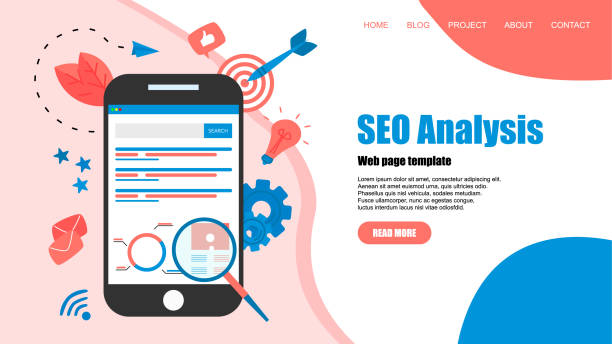1. Introduction to Responsive Website Design and Its Importance in the Current Era

Responsive website design (#responsive_design #mobile_website #site_optimization) is no longer just an optional feature for websites; it has become an absolute necessity.
In today’s world, where users access the internet from a variety of devices including smartphones, tablets, laptops, and even smart TVs, ensuring that your website looks appropriate and performs optimally on every screen size is crucial.
This approach guarantees that your website flexibly adjusts its layout and content based on the user’s screen dimensions, providing a seamless user experience.
Therefore, responsive website design not only helps retain users but also directly impacts the site’s ranking in search engines.
Google and other search engines prioritize responsive websites because these websites offer a better user experience, which is a key factor in their ranking algorithms.
A deep understanding of this concept is the first step towards building a successful online presence.
This is an explanatory and educational discussion that forms the foundation for all subsequent topics.
Without responsive website design, businesses risk losing a significant portion of their audience.
This not only affects user engagement but can also negatively impact conversion rates and overall profitability.
Ensuring accessibility across all devices sends a strong message to users that your website is modern, user-friendly, and committed to providing the best possible experience.
Do you know that a weak corporate site loses many opportunities for you daily? Solve this problem forever with professional corporate site design by Rasawb!
✅ Create a powerful and reliable image for your brand
✅ Attract targeted new customers and increase sales
⚡ [Get Free Website Design Consultation]
2. Fundamental Principles of Responsive Design: CSS Media Queries and Fluid Grids

#Media_Queries #Fluid_Grids #Fluid_Images
Responsive website design is based on three key principles: CSS Media Queries, Fluid Grids, and Fluid Images.
Media Queries allow developers to apply different CSS rules based on specific characteristics of the user’s device, such as screen width, orientation (portrait or landscape), and resolution.
This feature is the core of responsive design, as it enables the website’s appearance to change according to different screen requirements.
For example, you can adjust font sizes, column counts, and even the display of certain elements for smaller screens to prevent visual clutter and improve user experience.
Fluid Grids use relative units like percentages instead of fixed pixel units to define the width and height of elements.
This approach ensures that the website layout automatically adjusts with the screen size.
For instance, if an element has a width of 50%, it will always be half the screen width, regardless of whether the user is on a large monitor or a smartphone.
This specialized and educational principle provides the foundation for dynamically structuring content.
Fluid Images, by using the `max-width: 100%` property in CSS, ensure that images never exceed their container’s width while scaling appropriately.
This prevents layout breakage and reduces image loading times on mobile devices with lower bandwidth.
The combination of these three principles has made responsive website design an industry standard for building modern and user-friendly websites.
A deep understanding of these mechanisms is essential for any developer aiming to create highly adaptable websites.
3. Key Benefits of Responsive Website Design for Users and Businesses

#Better_User_Experience #Optimized_SEO #Cost_Reduction #Increased_Conversion_Rate
One of the most important benefits of responsive website design is the significant improvement in user experience (UX).
When a website displays well on all devices, users do not need to zoom, scroll horizontally, or navigate with difficulty.
This ease of use leads to increased user satisfaction and, consequently, longer site visits.
For businesses, this means an increase in conversion rates and a decrease in bounce rates.
Analysis and review show that Google ranks responsive websites higher in its mobile search results.
This is because Google aims to provide the best possible experience to its users, and responsive websites fulfill this need.
Having a single URL for all devices instead of separate URLs (e.g., m.example.com) simplifies SEO management and prevents duplicate content issues.
This is a very important analytical and explanatory advantage.
| Benefit | Explanation |
|---|---|
| Improved SEO | Prioritization by search engines for mobile display, reduction of duplicate content. |
| Unified User Experience | Easy access and correct display on all devices without the need for a separate version. |
| Reduced Maintenance Costs | Need to manage one codebase instead of multiple versions for different devices. |
| Increased Conversion Rate | Easier usability and increased customer satisfaction to purchase or perform desired action. |
Furthermore, responsive website design reduces development and maintenance costs.
Instead of developing and managing separate versions for desktop and mobile, there is only one website with a single codebase, which simplifies the update and debugging process, making it more cost-effective.
These benefits make adaptive design a smart investment for any business seeking long-term success in the digital space.
4. Increasing User Engagement and Optimizing for Search Engines

#User_Engagement #Mobile_SEO #Search_Engine_Optimization #Site_Ranking
Responsive website design not only improves your website’s appearance but also directly impacts how users interact with your content and plays a vital role in Search Engine Optimization (SEO).
A website that responds well to the needs of different devices encourages users to spend more time on the site, view more pages, and engage more deeply with your content.
This increased engagement sends positive signals to search engines, indicating the quality and value of your website.
From an SEO perspective, Google has explicitly stated that responsive website design is the preferred approach for mobile-compatible websites.
The reason for this is the ease of crawling and indexing websites that have a single URL and a common codebase for all devices.
This allows search bots to identify your content more efficiently and rank it correctly in search results.
This aspect of specialized guidance is very important for businesses looking to increase visibility and attract organic traffic.
Responsive websites also prevent issues related to duplicate content that might occur if there are separate mobile and desktop versions.
This ensures that your website’s Domain Authority remains concentrated and prevents it from being divided among multiple URLs.
Furthermore, given that most users today access the internet via mobile devices, having a mobile-optimized website means access to a larger market of potential audiences.
Optimizing your website for an excellent mobile user experience directly helps increase site ranking in mobile search results and ultimately contributes to increased traffic and profitability.
Are you tired of your e-commerce site having visitors but no sales? Rasawb solves your main problem with professional e-commerce site design!
✅ Significant increase in sales with targeted design
✅ Seamless user experience for your customers
⚡ Get free consultation now!
5. Common Challenges and Practical Solutions in Implementing Responsive Design

#Responsive_Challenges #Image_Optimization #Loading_Speed #Testability
Despite numerous advantages, implementing responsive website design also comes with challenges.
One of the biggest challenges is image optimization.
High-quality images suitable for large displays can cause slow loading on mobile devices.
The solution to this problem is to use responsive images, such as the `
Additionally, next-generation image formats like WebP can significantly help reduce file sizes.
Another challenge is managing the complexities of CSS and JavaScript to ensure optimal performance across all devices.
Over-coding or inefficient coding can lead to performance issues.
Using a Mobile-first approach in development, where design is first done for smaller screens and then progressively expanded for larger screens, can help simplify the process and improve performance.
This approach provides guidance and thought-provoking content on the best implementation practices.
Testability is also a significant challenge.
Ensuring that the website displays correctly on hundreds of different devices and browsers requires comprehensive testing tools and rigorous processes.
Using browser emulators, browser developer tools (like Chrome DevTools), and online testing platforms like BrowserStack can be very useful in this regard.
Also, paying attention to page loading speed on mobile devices, where users may have slower internet access, is crucial.
Code compression, caching, and server optimization can be effective in this area.
Addressing these challenges and implementing appropriate solutions significantly contributes to the success of responsive website design.
6. Popular Tools and Frameworks for Responsive Website Design

#Responsive_Tools #CSS_Framework #Bootstrap #React_JS
In the field of responsive website design, there are numerous tools and frameworks that can simplify and streamline the development process.
One of the most well-known and widely used frameworks is Bootstrap.
Bootstrap is an open-source front-end framework that includes HTML and CSS templates for typography, forms, buttons, tables, navigation, and other UI components, as well as optional JavaScript plugins.
Using Bootstrap’s responsive grid system helps developers quickly and easily create websites compatible with various devices.
This is an educational and specialized resource for anyone looking to enter this field.
Tailwind CSS is another popular framework that takes a different approach.
Instead of providing pre-built components, Tailwind CSS offers a set of utility-first classes that allow developers to build their desired user interface directly in HTML.
This approach provides more flexibility and helps reduce CSS file size but requires a deeper understanding of CSS.
Alongside CSS frameworks, JavaScript libraries like React.js, Vue.js, and Angular are increasingly used to build interactive and responsive user interfaces.
These frameworks, by using a component-based approach, enable modular and organized development, which is very useful for large-scale responsive websites.
Browser developer tools (like Chrome DevTools) are also essential for testing and debugging responsive websites.
They allow developers to see how the website appears at different screen sizes and identify potential issues.
The choice of the right tool depends on the project’s needs and the developer’s preferences, but all these tools have been developed with the aim of facilitating device-compatible design.
7. Performance Optimization and Loading Speed for Responsive Websites

#Performance_Optimization #Site_Speed #Image_Compression #Caching
Responsive website design is not limited to the website’s appearance; performance optimization and loading speed are also fundamental pillars.
A slow responsive website can severely disrupt the user experience and lead to an increased bounce rate, even if its appearance is excellent on all devices.
Users today expect web pages to load quickly and without delay, especially on mobile devices where they may have access to slower bandwidth internet.
| Optimization Technique | Explanation |
|---|---|
| Image Compression | Reducing the file size of images without significant quality loss (using WebP). |
| Minifying CSS/JS | Removing white spaces, comments, and extra characters from code files. |
| Using CDN | Distributing content from servers closer to the user to reduce latency. |
| Caching | Temporarily storing static content in the user’s browser for faster loading on subsequent visits. |
| Lazy Loading | Loading images and videos only when the user scrolls to them. |
One of the most important steps in this regard is image compression and the use of adaptive images.
As mentioned in previous chapters, using techniques like `
Additionally, optimizing CSS and JavaScript codes through minification and compression, as well as asynchronous loading of scripts, can help improve speed.
Using Content Delivery Networks (CDNs) to distribute static website files across multiple servers closer to users is also very effective in reducing loading latency.
Implementing caching mechanisms in the browser and server can also help speed up page reloads, as the browser will not need to re-download all files.
These analytical and specialized tips are crucial for any website aiming for a seamless user experience and high SEO ranking.
A responsive website that also has high performance will provide a significant competitive advantage.
8. Impact of Responsive Website Design on Online and Offline Businesses

#Increased_Sales #Strong_Branding #Greater_Accessibility #Competitive_Advantage
Responsive website design is more than a technical aspect; it is a business strategy that can have profound impacts on the online and even offline performance of companies.
For online businesses, having a responsive website means increased sales and conversions.
As more than half of web traffic comes from mobile devices, not optimizing for these devices means losing a large portion of potential customers.
A website that displays well on mobile gains user trust and simplifies the purchasing process for them.
This is a news and analytical look at the market.
Furthermore, device-compatible design helps strengthen branding and company credibility.
A website that performs well across all platforms sends a message of professionalism and attention to detail to the audience.
This can lead to improved customer perception of the brand and increased loyalty.
Even for offline businesses, a responsive website is of great importance.
Many customers first check a business’s website on their mobile phone before visiting a physical store or contacting a service.
Contact information, business hours, address, and customer reviews should be easily accessible and visible.
If the website does not provide a good experience on mobile, customers may opt out of your business before any physical interaction.
Ultimately, responsive website design is a significant competitive advantage.
In a highly competitive market, businesses that offer a superior user experience can not only attract new customers but also retain existing ones.
This investment not only leads to immediate return on investment but also significantly contributes to the long-term sustainability and growth of the business in the digital world.
Are your e-commerce site visitors leaving before purchasing? Don’t worry anymore! With Rasawb’s professional e-commerce site design services, solve the problem of not converting visitors into customers forever!
✅ Significant increase in conversion rates and sales
✅ Seamless and engaging user experience
⚡ Contact us now for a free consultation!
9. The Future of Web Design: A Look Beyond Responsiveness

#Future_of_Web_Design #Adaptive_Design #Progressive_Web_Apps #AMP
While responsive website design remains the golden standard for modern websites, the future of web design is moving towards more advanced concepts such as adaptive design and Progressive Web Apps (PWAs).
Adaptive design, instead of continuous flexibility, provides fixed layouts for specific screen sizes.
This approach can, in some cases, offer more control over the user experience on specific devices, but it typically requires more complex development and maintenance.
This is an entertaining and news-oriented look at future trends.
PWAs are the next step in web evolution.
They offer a combination of the best features of websites and mobile applications.
PWAs can work offline, send push notifications, and even be installed as an icon on the phone’s home screen, just like a native application.
This technology provides a much richer and faster user experience, blurring the line between websites and native applications.
Google AMP (Accelerated Mobile Pages) is another technology designed to speed up the loading of web pages on mobile, especially for news content and articles.
Device-compatible design is evolving, and with the emergence of new devices such as foldable displays and Augmented/Virtual Reality (AR/VR), the need for even more dynamic and flexible design solutions is felt.
The concept of “future-proof design” means that websites should be designed in a way that they can adapt to emerging technologies, rather than requiring a complete rebuild with every major change.
This requires the use of modern web standards, modular architectures, and strategic thinking in web design to ensure websites remain relevant and efficient for years to come.
10. Conclusion and Best Practices for Successful Responsive Design Implementation

#Conclusion #Best_Practices #Mobile_First #Continuous_Support
In conclusion, responsive website design is no longer a luxury option but a requirement for any modern website.
This approach not only significantly improves user experience but also brings significant benefits in SEO, reduced maintenance costs, and increased conversion rates for businesses.
Given the increasing use of mobile devices to access the internet, investing in a responsive website is a strategic and vital decision for success in the digital space.
This is a comprehensive guide and explanation.
For successful implementation of responsive website design, adherence to best practices is essential:
- Mobile-First Approach: Start designing and developing for the smallest screens first, and then progressively expand for larger devices.
This approach helps you focus on core content and functionality. - Use Relative Units: Use relative units like percentages, `em`, and `rem` for dimensions (width, height, fonts) so that elements scale flexibly.
- Image Optimization: Use adaptive images and next-generation image formats to minimize loading times on different devices.
- Continuous Testing: Regularly test your website on various devices and browsers to ensure compatibility and correct functionality.
- Focus on Performance: Always focus on loading speed and overall website performance, as these factors directly impact user experience and SEO ranking.
Adopting and implementing these principles will help you have a strong and effective responsive website design that not only meets current user needs but is also ready for the digital future.
This is an investment in user experience, SEO, and ultimately, in your business’s success.
Frequently Asked Questions
| Question | Answer |
|---|---|
| What is Responsive Web Design? | It is a method for designing and implementing websites that automatically adjusts the layout and content of the page based on the user’s device screen size (desktop, tablet, mobile, etc.) and displays it optimally. |
| Why is Responsive Design important? | With the increasing use of various devices to access the web, a responsive site improves user experience, reduces bounce rate, enhances site SEO, and simplifies site management and maintenance (instead of having separate versions for mobile and desktop). |
| How does Responsive Design work? | This type of design uses techniques such as flexible grids and layouts (Flexbox, CSS Grid), flexible images and media, and most importantly, CSS Media Queries to change the page’s styles and layout based on screen characteristics (width, height, resolution, etc.). |
| What are the main tools for implementing Responsive Design? | Main tools include HTML5 (for content structure), CSS3 (especially Media Queries, Flexbox, Grid for styling and responsive layout), and sometimes JavaScript for more complex interactions. |
| What are the main benefits of using Responsive Design? | The main benefits include increased user accessibility (covering a wide range of devices), improved user experience, improved site ranking in search engines (especially Google), reduced development and maintenance costs, and increased conversion rates from visitors to customers. |
And other advertising agency services from Rasawb in the field of advertising
Smart Data Analysis: A creative platform to improve SEO ranking with Google Ads management.
Smart Link Building: An effective tool for campaign management with the help of SEO-driven content strategy.
Smart Advertising Campaign: A creative platform to improve campaign management using real data.
Smart Customer Journey Map: An innovative service to increase SEO ranking through user experience customization.
Smart Brand Identity: A professional solution for campaign management with a focus on SEO-driven content strategy.
And over hundreds of other services in the field of internet advertising, advertising consultation, and organizational solutions
Internet Advertising | Advertising Strategy | Advertorials
Sources
Responsive Website Design: A Comprehensive Guide
From Web 1.0 to Web 3.0: The Evolution of the Web
The Digital Future and the Role of Web Design in It
New Trends in Web Design and the Digital Future
? Are you ready to revolutionize your business in the digital world? Rasawb Afarin, with expertise in SEO-optimized website design and comprehensive digital marketing solutions, is your bridge to endless successes.
📍 Tehran, Mirdamad Street, next to Bank Markazi, Kazeroon Jonubi Alley, Ramin Alley, No. 6



